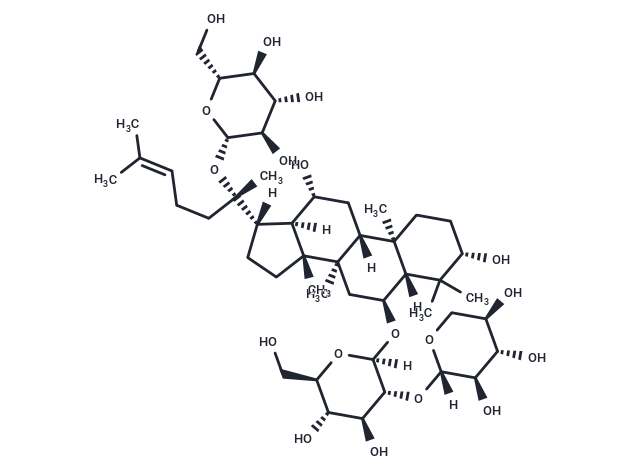Shopping Cart
Remove All Your shopping cart is currently empty
Your shopping cart is currently empty
Notoginsenoside R1 (Sanchinoside R1) has been shown to exhibit antioxidant, antiapoptotic, anti-inflammatory, and immune-stimulatory properties.

| Pack Size | Price | USA Warehouse | Global Warehouse | Quantity |
|---|---|---|---|---|
| 10 mg | $37 | In Stock | In Stock | |
| 25 mg | $68 | In Stock | In Stock | |
| 50 mg | $98 | In Stock | In Stock | |
| 100 mg | $156 | In Stock | In Stock | |
| 200 mg | $243 | In Stock | In Stock | |
| 500 mg | $425 | In Stock | In Stock | |
| 1 mL x 10 mM (in DMSO) | $38 | In Stock | In Stock |
| Description | Notoginsenoside R1 (Sanchinoside R1) has been shown to exhibit antioxidant, antiapoptotic, anti-inflammatory, and immune-stimulatory properties. |
| In vitro | METHODS: Human colorectal cancer cells HCT-116 were treated with Notoginsenoside R1 (75-300 µM) for 48 h. Cell viability was measured by MTT assay. RESULTS: Cell viability of HCT-116 cells treated with 75-300 µM Notoginsenoside R1 was not significantly different from that of the control. However, treatment with 500 µM Notoginsenoside R1 for 48 h resulted in a significant decrease in cell viability (58±7.26%) compared to control cells. [1] METHODS: Human coronary artery smooth muscle cells hCASMC were treated with Notoginsenoside R1 (10 µM) for 24 h. The cells were stimulated with 10% FBS for 0-30 min, and the expression levels of target proteins were detected by Western Blot. RESULTS: Akt phosphorylation in hCASMCs was rapidly reduced in a time- and dose-dependent manner after Notoginsenoside R1 treatment, but no effect on ERK1/2 and JNK signaling was observed. notoginsenoside R1 caused a modest reduction in p38 MAPK phosphorylation, but this did not reach significance. [2] |
| In vivo | METHODS: To study the effect on neoplastic endothelial hyperplasia, Notoginsenoside R1 (10 mg/kg) was administered intraperitoneally to C57BL/6 J mice once daily for three weeks. A mouse femoral artery injury model was subsequently performed. RESULTS: Notoginsenoside R1 attenuated neointimal formation after femoral artery injury in vivo.Notoginsenoside R1 treatment reduced neointimal formation by inhibiting VSMC proliferation. [2] |
| Synonyms | Sanqi glucoside R1, Sanchinoside R1 |
| Molecular Weight | 933.13 |
| Formula | C47H80O18 |
| Cas No. | 80418-24-2 |
| Smiles | [H][C@@]1(CC[C@]2(C)[C@]1([H])[C@H](O)C[C@]1([H])[C@@]3(C)CC[C@H](O)C(C)(C)[C@]3([H])[C@H](C[C@@]21C)O[C@]1([H])O[C@H](CO)[C@@H](O)[C@H](O)[C@H]1O[C@]1([H])OC[C@@H](O)[C@H](O)[C@H]1O)[C@](C)(CCC=C(C)C)O[C@@H]1O[C@H](CO)[C@@H](O)[C@H](O)[C@H]1O |
| Relative Density. | 1.39 g/cm3 (Predicted) |
| Color | White |
| Appearance | Solid |
| Storage | Powder: -20°C for 3 years | In solvent: -80°C for 1 year | Shipping with blue ice/Shipping at ambient temperature. | ||||||||||||||||||||||||||||||||||||||||
| Solubility Information | H2O: 2.5 mg/mL (2.68 mM), Sonication is recommended. DMSO: 247.5 mg/mL (265.24 mM), Sonication is recommended. | ||||||||||||||||||||||||||||||||||||||||
| In Vivo Formulation | 10% DMSO+90% Saline: 2.5 mg/mL (2.68 mM), Solution. Please add the solvents sequentially, clarifying the solution as much as possible before adding the next one. Dissolve by heating and/or sonication if necessary. Working solution is recommended to be prepared and used immediately. The formulation provided above is for reference purposes only. In vivo formulations may vary and should be modified based on specific experimental conditions. | ||||||||||||||||||||||||||||||||||||||||
Solution Preparation Table | |||||||||||||||||||||||||||||||||||||||||
H2O/DMSO
DMSO
| |||||||||||||||||||||||||||||||||||||||||
| Size | Quantity | Unit Price | Amount | Operation |
|---|

Copyright © 2015-2025 TargetMol Chemicals Inc. All Rights Reserved.